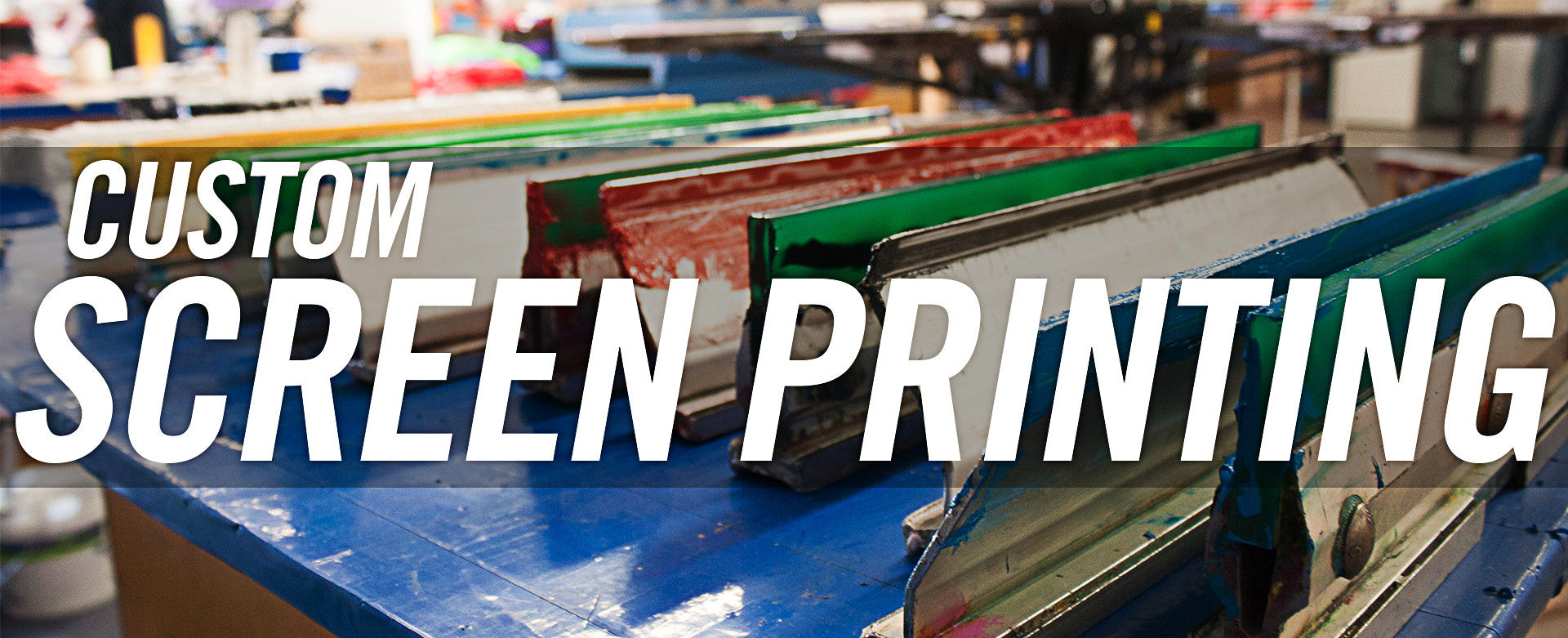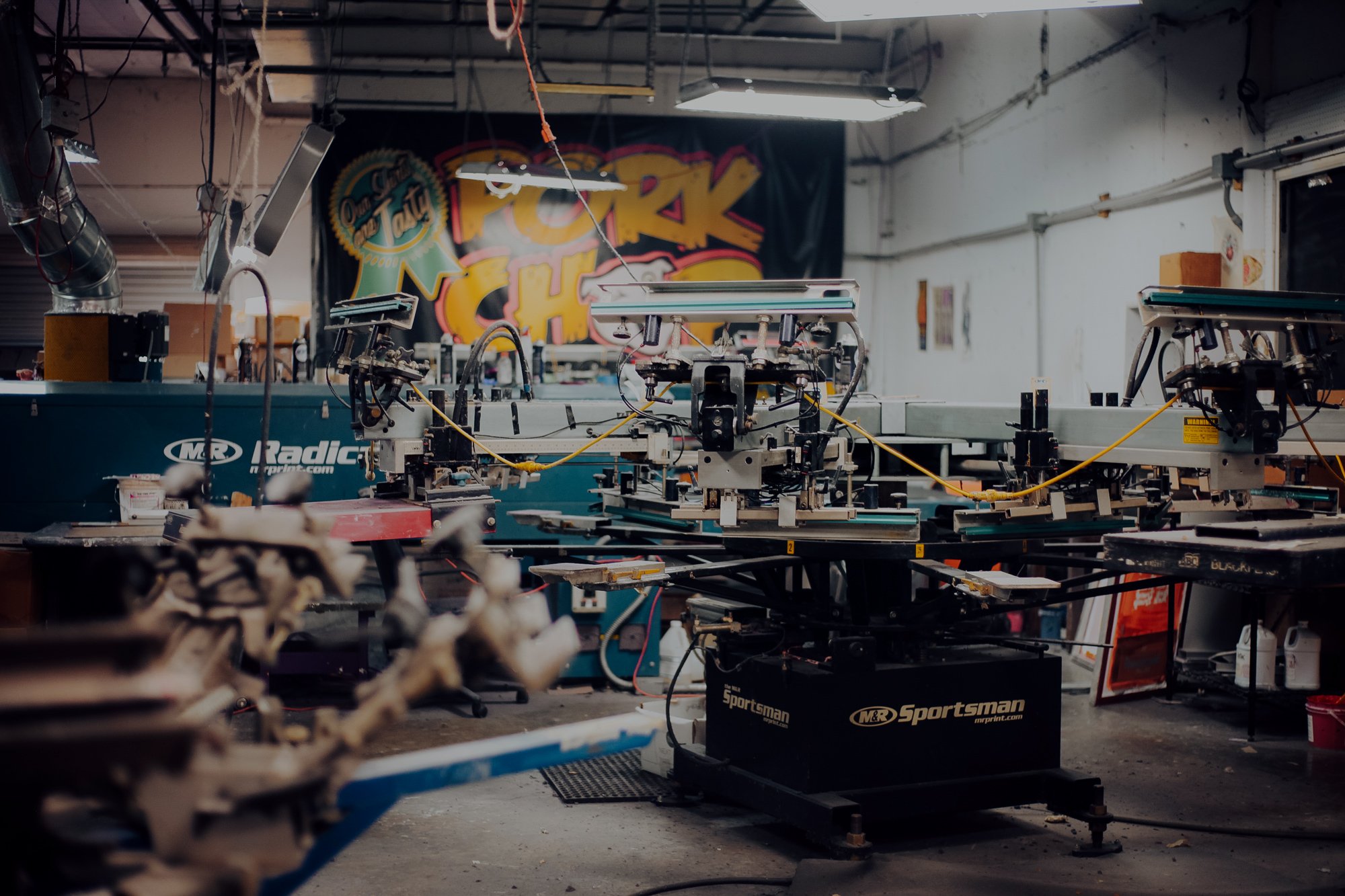Screen Printing Uncovered: Every Little Thing You Need to Understand About Tee Shirt and Garment Printing Techniques
Screen printing is an interesting approach that combines art with strategy, providing unlimited opportunities for imagination. All set to discover the necessary components that make display publishing an art kind?
The Essentials of Display Printing: How It Works
When you dive into screen printing, you'll find it's both a scientific research and an art. At its core, screen printing includes creating a stencil, or display, that enables ink to pass through only in particular locations.
Following, you'll blend your inks and prepare your printing surface. Position the display over the fabric, after that make use of a squeegee to push ink through the screen onto the garment. This process calls for precision, as you want clear, vivid prints. After printing, you'll treat the ink with warm, ensuring it complies with the material and lasts through cleans. Each action is important, and understanding them will raise your screen printing skills, transforming straightforward garments into unique, expressive pieces.
Kinds of Display Printing Techniques
When you realize the essentials of display printing, it's time to discover the various strategies that can boost your layouts. One popular technique is conventional display printing, where ink is pressed with a stenciled display. This technique is excellent for strong, vibrant colors. Then there's water-based ink printing, which offers a softer feeling and is environmentally friendly, yet it requires a various technique to healing.
Another alternative is plastisol printing, understood for its resilience and dazzling colors, making it a preferred for many brand names. Experiment with halftone printing to produce slope effects and complex styles.
Essential Equipment for Screen Printing
To achieve magnificent lead to display printing, having the ideal devices is fundamental. Initially, you'll need a durable screen printing framework, which holds the mesh that transfers your layout onto the garment. Next, buy top quality squeegees; these are crucial for applying ink uniformly across the display. You'll also require a great direct exposure unit to create your screens, in addition to a washout booth for cleaning them after usage. A trustworthy heat resource, like a conveyor clothes dryer or heat press, is important for healing your prints to guarantee long life. Do not neglect a proper work area, furnished with tables and storage space for your supplies. Lastly, protective equipment, such as handwear covers and masks, will keep you safe from chemicals and inks. With the right tools, you'll be well on your means to creating professional-quality prints.
Selecting the Right Inks and Products
When picking inks and products for screen printing, you need to consider the kind of ink that works best for your project. Think of textile compatibility to ensure your layouts look terrific and last lengthy. Likewise, check out environmentally friendly ink choices to make your printing process more sustainable.
Sorts Of Screen Inks
Picking the right screen ink is essential for accomplishing dynamic, sturdy prints that meet your job's demands. There are numerous kinds of display inks to examine. Specialty inks, such as metal or glow-in-the-dark, can include one-of-a-kind effects to your designs.

Material Compatibility Considerations
Comprehending fabric compatibility is vital for achieving high-quality screen prints, specifically given that various products respond distinctively to different inks. When choosing inks, consider the textile kind-- cotton, polyester, or blends. For cotton, water-based inks work well, offering soft qualities and breathability. Polyester, on the various other hand, typically needs plastisol inks for better attachment and lively colors. You might require to utilize a combination of both kinds if you're publishing on blends. Always examine your inks on example fabric to assure they adhere properly and keep color honesty. Furthermore, bear in mind that textile weight and structure can affect the last outcome, so choosing the right ink and product combo is essential for your project's success.
Eco-Friendly Ink Options
Eco-friendly inks are ending up being a prominent option for display printers who want to decrease their environmental effect while maintaining high quality. When picking inks, consider water-based inks, which are much less harmful and easier to clean up compared to standard solvents.
Furthermore, try to find inks made from renewable energies, such as soy or vegetable-based options. By picking the best inks and materials, you'll not just produce stunning designs but likewise contribute to a much more sustainable printing process. Make the switch, and your prints will certainly mirror your dedication to the atmosphere!
Preparing Your Layout for Screen Printing

Submit Format Demands
To guarantee your style looks vivid and sharp on material, you'll require to pay close interest to submit layout requirements for screen printing. Make certain your style has a transparent background to protect against unwanted white sides on your prints. Maintain shade settings in mind; CMYK is basic for screen printing, so convert your RGB creates appropriately.
Color Separation Strategies
Shade splitting up is a vital action in preparing your style for display printing, and mastering it can significantly boost your print top quality. You'll require to break your style into individual colors, as each shade requires a different display throughout printing. Beginning by determining all the colors in your layout and produce layers for each one. You can make use of software like Adobe Photoshop or Illustrator to isolate and different colors efficiently. Be specific to conserve each layer as a separate documents, generally in a format like TIFF or PSD. This precision not just ensures precise color representation yet also simplifies the printing procedure. By focusing on color splitting up, you'll attain expert and dynamic cause your screen-printed garments.
Resolution and Size
Attaining the very best cause display printing begins with ensuring your design has the right resolution and size. Preferably, your art work needs to be at least 300 DPI (dots per inch) for sharp, clear prints. If you make use of lower resolution, your last product may look pixelated and less than professional.
When it comes to size, consider the dimensions of your print location. Style your artwork to match the last print size, ideally producing it in the actual dimensions you'll be publishing. By doing this, you'll avoid any kind of unexpected scaling issues.
Always inspect your layout in both vector and raster layouts. Vector graphics can be scaled without shedding top quality, making them suitable for screen printing. Preparing correctly will assure your style looks amazing on every garment!
Step-by-Step Screen Printing Refine
Screen printing is a dynamic procedure that allows you to develop vibrant designs on numerous surfaces. To get started, you'll need a display, emulsion, and your picked ink.
After rinsing the unexposed emulsion, your screen is ready. Establish it up on your printing surface and align your garment beneath it. Put ink onto the display and make use of a squeegee to press the ink with the stencil onto the material. Raise the display very carefully and let the print dry. Cure the ink utilizing heat to assure sturdiness. That's it! You have actually effectively display printed your design.
Tips for Effective Display Printing Projects
While you're diving into your screen printing projects, bear in mind that preparation is key to success. Begin by collecting all your materials-- inks, screens, garments, and squeegees. A tidy work space aids avoid undesirable mistakes, so neat up before you begin.
Next, verify your artwork is high-resolution and properly sized for your garment. Check your screen for appropriate direct exposure and tidy it thoroughly to avoid spots. When mixing your inks, comply with the maker's guidelines to achieve the right consistency.
During printing, apply even stress with your squeegee for consistent results. Do not hurry; take your time to validate each print meets your criteria. After printing, allow your silk screen printing garments dry entirely before managing or packaging them.
Last but not least, constantly maintain an example of your job for future reference. This means, you can examine your development and enhance your strategies gradually. Pleased printing!

Regularly Asked Inquiries
Exactly how Long Does It Require To Establish a Screen Printing Task?
Establishing up a screen printing work normally takes around 30 minutes to an hour. You'll prepare the screens, mix inks, and readjust journalism. The time differs based on intricacy and experience, so stay arranged!
Can I Print on Various Textile Enters Using the Same Method?
Yes, you can publish on different textile kinds using the same technique, however you'll need to adjust your setups and inks. Some fabrics take in ink in a different way, so trying out warranties the most effective results for each and every product.
What Are Common Errors to Prevent in Display Printing?
When display printing, stay clear of common errors like utilizing the wrong ink, ignoring appropriate direct exposure times, or avoiding pre-press checks. Always check your setup and maintain tidy screens to guarantee high quality results each time.
Just How Can I Correctly Tidy and Keep My Display Printing Tools?
To correctly tidy and preserve your screen printing equipment, you ought to on a regular basis wash screens with proper solvents, check squeegees for wear, and guarantee all tools are kept dry and dust-free. Consistency enhances and avoids pricey repair services performance.
Is Screen Printing Ecologically Pleasant Contrasted to Other Techniques?
Screen printing can be a lot more environmentally pleasant than various other methods, specifically if you use eco-conscious materials and water-based inks. By picking lasting products and practices, you decrease waste and decrease your effect on the world.
Display Printing Uncovered: Every Little Thing You Required to Know Concerning T-Shirt and Garment Printing Methods
At its core, display printing involves creating a pattern, or display, that permits ink to pass with only in specific locations. Setting the screen over the material, after that make use of a squeegee to press ink via the screen onto the garment. One popular method is conventional screen printing, where ink is pushed via a stenciled display.When choosing inks and products for screen printing, you need to take into account the type of ink that functions finest for your task.
Comments on “Durable T-Shirt Printing for Everyday Wear”